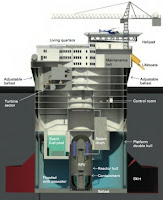A nuclear power plant that will float eight or more miles out to sea promises to be safer, cheaper, and easier to deploy than today’s land-based plants.
Many experts cite nuclear power as a critical component of a low-carbon energy future. Nuclear plants are steady, reliable sources of large amounts of power; they run on inexpensive and abundant fuel; and they emit no carbon dioxide (CO2).
A novel nuclear power plant that will float eight or more miles out to sea promises to be safer, cheaper, and easier to deploy than today’s land-based plants. In a concept developed by MIT researchers, the floating plant combines two well-established technologies — a nuclear reactor and a deep-sea oil platform. It is built and decommissioned in a shipyard, saving time and money at both ends of its life. Once deployed, it is situated in a relatively deep water well away from coastal populations, linked to land only by an underwater power transmission line. At the specified depth, the seawater protects the plant from earthquakes and tsunamis and can serve as an infinite source of cooling water in case of emergency — no pumping needed. An analysis of potential markets has identified many sites worldwide with physical and economic conditions suitable for deployment of a floating plant.
“More than 70 new nuclear reactors are now under construction, but that’s not nearly enough to make a strong dent in CO2 emissions worldwide,” says Jacopo Buongiorno, professor of nuclear science and engineering (NSE) at MIT. “So the question is, why aren’t we building more?”
...
Buongiorno cites several challenges to this vision. First, while the fuel is cheap, building a nuclear plant is a long and expensive process often beset by delays and uncertainties. Second, siting any new power plant is difficult: land near sources of cooling water is valuable, and local objection to construction may be strenuous. And third, the public in several important countries has lost confidence in nuclear power. Many people still clearly remember the 2011 accident at the Fukushima nuclear complex in Japan, when an earthquake created a tsunami that inundated the facility. Power to the cooling pumps was cut, fuel in the reactor cores melted, radiation leaked out, and more than 100,000 people were evacuated from the region.
In light of such concerns, Buongiorno and his team — Michael Golay, professor of NSE; Neil Todreas, the KEPCO Professor of Nuclear Science and Engineering and Mechanical Engineering; and their NSE and mechanical engineering students — have been investigating a novel idea: mounting a conventional nuclear reactor on a floating platform similar to those used in offshore oil and gas drilling, and mooring it about 10 miles out to sea.
...
The researchers' vision for an Offshore Floating Nuclear Plant (OFNP, visible left and above) includes a main structure about 45 meters in diameter that will house a plant generating 300 megawatts of electricity. An alternative design for a 1,100-MW plant calls for a structure about 75 meters in diameter. In both cases, the structures include living quarters and helipads for transporting personnel — similar to offshore oil drilling platforms.
Read more at A New Look for Nuclear Power: MIT News


No comments:
Post a Comment